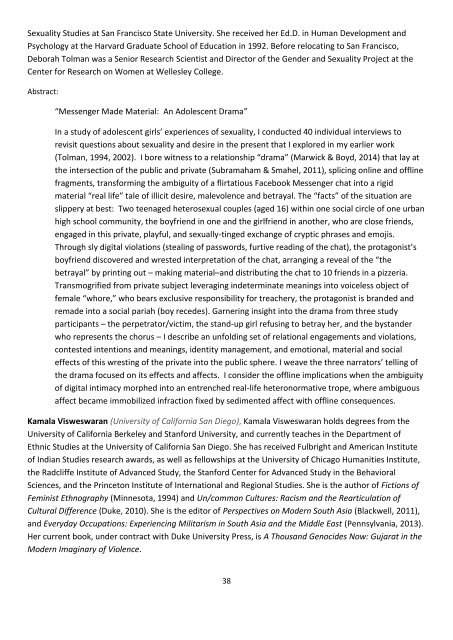Crossroads in Cultural Studies Conference 14-17th December 2016 Program Index
Crossroads-2016-final-draft-program-30-Nov
Crossroads-2016-final-draft-program-30-Nov
You also want an ePaper? Increase the reach of your titles
YUMPU automatically turns print PDFs into web optimized ePapers that Google loves.
Sexuality <strong>Studies</strong> at San Francisco State University. She received her Ed.D. <strong>in</strong> Human Development and<br />
Psychology at the Harvard Graduate School of Education <strong>in</strong> 1992. Before relocat<strong>in</strong>g to San Francisco,<br />
Deborah Tolman was a Senior Research Scientist and Director of the Gender and Sexuality Project at the<br />
Center for Research on Women at Wellesley College.<br />
Abstract:<br />
“Messenger Made Material: An Adolescent Drama”<br />
In a study of adolescent girls’ experiences of sexuality, I conducted 40 <strong>in</strong>dividual <strong>in</strong>terviews to<br />
revisit questions about sexuality and desire <strong>in</strong> the present that I explored <strong>in</strong> my earlier work<br />
(Tolman, 1994, 2002). I bore witness to a relationship “drama” (Marwick & Boyd, 20<strong>14</strong>) that lay at<br />
the <strong>in</strong>tersection of the public and private (Subramaham & Smahel, 2011), splic<strong>in</strong>g onl<strong>in</strong>e and offl<strong>in</strong>e<br />
fragments, transform<strong>in</strong>g the ambiguity of a flirtatious Facebook Messenger chat <strong>in</strong>to a rigid<br />
material “real life” tale of illicit desire, malevolence and betrayal. The “facts” of the situation are<br />
slippery at best: Two teenaged heterosexual couples (aged 16) with<strong>in</strong> one social circle of one urban<br />
high school community, the boyfriend <strong>in</strong> one and the girlfriend <strong>in</strong> another, who are close friends,<br />
engaged <strong>in</strong> this private, playful, and sexually-t<strong>in</strong>ged exchange of cryptic phrases and emojis.<br />
Through sly digital violations (steal<strong>in</strong>g of passwords, furtive read<strong>in</strong>g of the chat), the protagonist’s<br />
boyfriend discovered and wrested <strong>in</strong>terpretation of the chat, arrang<strong>in</strong>g a reveal of the “the<br />
betrayal” by pr<strong>in</strong>t<strong>in</strong>g out – mak<strong>in</strong>g material–and distribut<strong>in</strong>g the chat to 10 friends <strong>in</strong> a pizzeria.<br />
Transmogrified from private subject leverag<strong>in</strong>g <strong>in</strong>determ<strong>in</strong>ate mean<strong>in</strong>gs <strong>in</strong>to voiceless object of<br />
female “whore,” who bears exclusive responsibility for treachery, the protagonist is branded and<br />
remade <strong>in</strong>to a social pariah (boy recedes). Garner<strong>in</strong>g <strong>in</strong>sight <strong>in</strong>to the drama from three study<br />
participants – the perpetrator/victim, the stand-up girl refus<strong>in</strong>g to betray her, and the bystander<br />
who represents the chorus – I describe an unfold<strong>in</strong>g set of relational engagements and violations,<br />
contested <strong>in</strong>tentions and mean<strong>in</strong>gs, identity management, and emotional, material and social<br />
effects of this wrest<strong>in</strong>g of the private <strong>in</strong>to the public sphere. I weave the three narrators’ tell<strong>in</strong>g of<br />
the drama focused on its effects and affects. I consider the offl<strong>in</strong>e implications when the ambiguity<br />
of digital <strong>in</strong>timacy morphed <strong>in</strong>to an entrenched real-life heteronormative trope, where ambiguous<br />
affect became immobilized <strong>in</strong>fraction fixed by sedimented affect with offl<strong>in</strong>e consequences.<br />
Kamala Visweswaran (University of California San Diego), Kamala Visweswaran holds degrees from the<br />
University of California Berkeley and Stanford University, and currently teaches <strong>in</strong> the Department of<br />
Ethnic <strong>Studies</strong> at the University of California San Diego. She has received Fulbright and American Institute<br />
of Indian <strong>Studies</strong> research awards, as well as fellowships at the University of Chicago Humanities Institute,<br />
the Radcliffe Institute of Advanced Study, the Stanford Center for Advanced Study <strong>in</strong> the Behavioral<br />
Sciences, and the Pr<strong>in</strong>ceton Institute of International and Regional <strong>Studies</strong>. She is the author of Fictions of<br />
Fem<strong>in</strong>ist Ethnography (M<strong>in</strong>nesota, 1994) and Un/common Cultures: Racism and the Rearticulation of<br />
<strong>Cultural</strong> Difference (Duke, 2010). She is the editor of Perspectives on Modern South Asia (Blackwell, 2011),<br />
and Everyday Occupations: Experienc<strong>in</strong>g Militarism <strong>in</strong> South Asia and the Middle East (Pennsylvania, 2013).<br />
Her current book, under contract with Duke University Press, is A Thousand Genocides Now: Gujarat <strong>in</strong> the<br />
Modern Imag<strong>in</strong>ary of Violence.<br />
38


